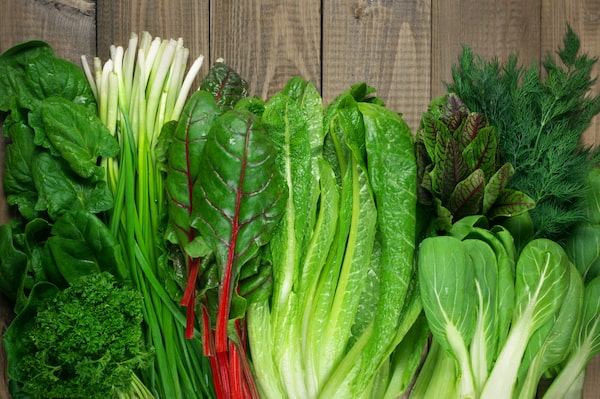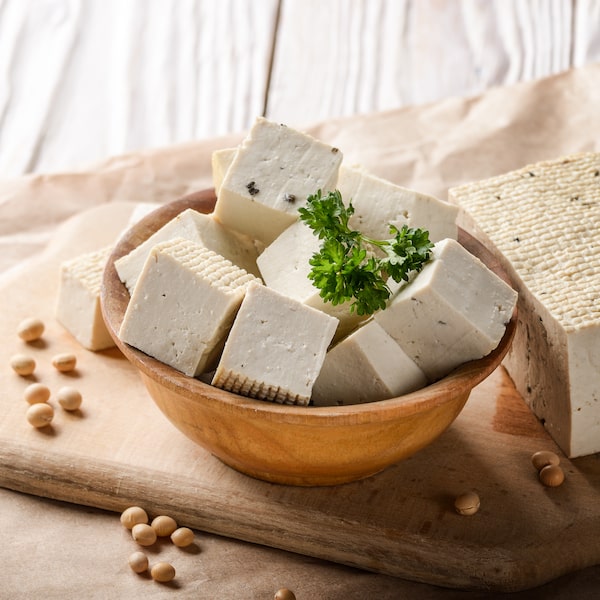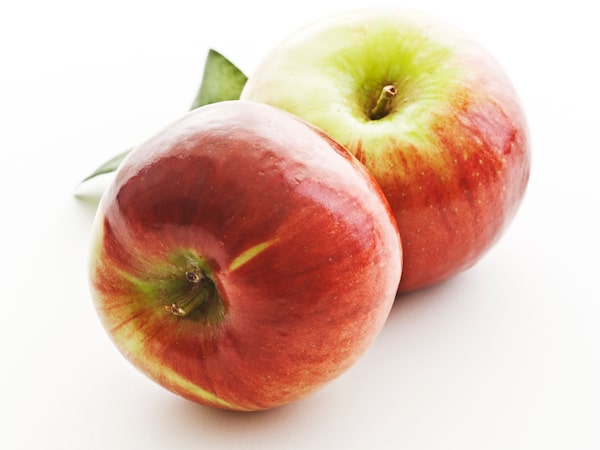The word “salad” comes from the Latin word sal, which means salt. In Roman times, salads were leaves dressed with a salty, oily dressing. That’s still the classic, but since then, modern salads have veered to include creamy dressings, pasta and proteins – not to mention those unfortunate couple of decades when they were encased in Jello.
Lucy and I agree that making a good salad is an art, but our agreement stops there. Her salads are side dishes with beautiful, seasonal greens, herbs and occasionally flowers. As someone who could live happily without ever seeing lettuce again, I dress up my salads with cheese, textural add-ins and usually a roasted vegetable or tangy fruit.
Salads can be simple or creative. A satisfying, complex salad meal has a balance of tastes and texture – think sweet, salty, acidic and earthy with each bite being different. But don’t forget that a simple side salad with greens is also a good addition to a meal where the main dish is the star. Salads can be a great way to use up extra bits that are languishing in the fridge and a good dressing can hold together a range of flavours.
We have suggested a stock dressing with possible additions, and a long list of components that, together, can add up to either a simple concoction or a bowl piled with a dizzying number of elements. Take our suggestions as a springboard to a creative main course or simple side.
To build a truly great side salad, take one thing from each category (perhaps skipping the proteins) and mix it together. For a more filling, grain-based salad, load up on items from the texture column.

Different lettuces impart different flavours and the best salads mix up multiple green leafy vegetables.Svetlana Lukienko/iStockPhoto / Getty Images
Add a variety of lettuce greens
Different lettuces impart different flavours and the best salads mix up one or two (although tender, lighter lettuces sometimes get lost among more aggressive greens). Remember to pair a more aggressive dressing with the hardier and spicier greens. Toss in some beautiful edible flowers to finish.
- Spicy lettuces: arugula, watercress, mizuna, tatsoi;
- Tender lettuces: Boston, bibb, mâche;
- Crisp lettuces: iceberg, romaine, little gem;
- Bitter lettuces: radicchio, endive, escarole, frisée, baby kale;
- Kale: Destemming is a must, as is some prep to improve the texture. Either massage the kale with the dressing or some oil and salt to soften it before making the salad, or rinse it under hot water, squeeze with your hands and let dry.
- Sprouts: sunflower, mustard greens, arugula or any of the greenhouse-grown sprouts will all add nice texture;
- Salad mixes: The amount of lettuce varies in each mix but there are generally three to eight lettuces included. These are useful because they don't need to be washed, but often don't have much flavour.
- Fresh herbs: mint, basil, cilantro, chives, tarragon, oregano;
- Edible flowers.
Add texture like grains, seeds or nuts
This column gives salads another dimension as well as increased nutrition. Grains can be substituted for leaves as a base for a main course or hearty side: Because grains soak up dressing, add a little more than usual and taste before serving.
- Seeds: pumpkin, hemp, sunflower, sesame
- Toasted nuts: walnuts, cashews, almonds, pine nuts
- Croutons: homemade from leftover bread, pita, naan, torn tortillas
- Grains: precooked quinoa, lentils, wheatberries, farro, wild rice, chick peas, brown rice, bulghur
- Other crunchies: granola, coconut chips, puffed rice, kale chips, crushed tortilla chips, crispy rice noodles
- Dried fruits: cranberries, blueberries, mangos, cherries, apricots

Soy Bean curd tofu in wooden bowl on kitchen table. Non-dairy alternative substitute for cheeseiStockPhoto / Getty Images
Add a protein like tofu or cheese
For Emma, a salad without cheese is a sad bowl of greens. Adding any kind of protein (cheese, meat, tofu, seafood) turns the dish into a nutritionally complete meal and makes a perfect lunch, or a light main course dinner. If taking to work for a sad desk lunch, pack the dressing and protein separately.
- Soft: feta, goat cheese, buffalo milk ricotta, fresh mozzarella/boccocini, blue cheese, regular ricotta;
- Hard: slivers of Parmesan, grated pecorino, chunks of aged cheddar, grated manchego;
- Meat: bacon, prosciutto, barbecue chicken, smoked turkey, smoked trout, smoked salmon;
- Vegetarian proteins: hard tofu, marinated and baked; preflavoured tofu, tempeh.

Vegetables add a range of colour, flavour and nutrients to your salad greens.Dmitriy83/iStockPhoto / Getty Images
Add the rainbow: Toss in roasted, raw or pickled vegetables
These add a range of colour and flavour to the greens. If you want to pack an additional nutritional punch, try adding summer’s healthiest vegetables: asparagus, cauliflower, Swiss chard, red peppers, or eggplant.
- Roasted: delica or roasted butternut squash, sweet potatoes, broccoli, red peppers, cauliflower, asparagus
- Raw: jicama, grated carrots, sliced onions, sugar snap peas, avocado, slivers of cabbage, snow pea greens, peppers, sprouts
- Pickled: cucumbers, turnip, radishes, onions, kimchi, jalapenos;

When it comes to adding fruit in salads, apples and pears go well with strong cheese, while peaches and watermelon are great with salty dressings.ISTOCKPHOTO/stock
Add a playful element: fruit
Use fruit playfully but sparingly, as it can overwhelm a salad with sweetness. Apples and pears go well with strong cheese, while peaches and watermelon are great with salty dressings or a bitter lettuce and tropical fruits work well with Asian dressings.
- Crunchy: apples, pears;
- Soft: berries, peaches, sliced grapes, watermelon, pomegranate, mango, papaya.

The base of any good salad is the dressingVeselovaElena/iStockPhoto / Getty Images
Add a balanced salad dressing
While Lucy and I may agree to disagree on what makes a good base salad, we both believe that the base of any good salad is the dressing. The best ingredients are elevated by a balanced vinaigrette, and even back-of-the-veggie-drawer salads can be improved with the right formula. Ours is the same, respecting the all-important vinaigrette proportions of about one part acid (vinegar, lemon juice) to three parts oil.
What's the healthiest oil for salad dressings?
Making salad dressing in bulk is the best way to avoid the oversweet and expensive dressing at the grocery store. Feel free to double or triple this basic vinaigrette recipe, and add in different flavourings to personalize it to the day’s specific salad.
Remember that oil solidifies in the fridge: Unlike store-bought, a homemade dressing needs to come to room temperature and vigorously shaken before it can be used. But despite its sometime odd appearance, this basic homemade vinaigrette can be stored for at least four weeks.
Oils carry the flavour of the vinaigrette. Use good quality extra virgin olive oil or vegetable oils such as grapeseed, sunflower or safflower. For a flavour change, try nut oils such as hazelnut or walnut. They combine well with fruit vinegars and are at their best on plain green salads that do not fight with their flavour.
Different vinegars and acidic fruits such as lemon or lime juice can open up a whole new panorama of tastes. Their sharp taste cuts through the oil, balancing the vinaigrette. All vinegars can be used in salad dressings, but some are better than others.
We find ordinary plain white vinegar too tart; it gives an acidic taste to the dressing. In our opinion, red and white wine vinegars, because of their milder acidic qualities, are the mainstay of salad dressings. White wine vinegar creates a pale, creamy vinaigrette and is Lucy's preference. Emma leans toward sweeter, less acidic balsamic vinegar: An excellent one is expensive, but is bold enough to be used on its own.
Flavoured vinegars such as tarragon or basil lend a whole different variety of tastes. Sherry vinegar gives a rich mellowness to a vinaigrette, while fruit-flavoured vinegars are light and fresh. Raspberry and blueberry vinegars work well with salads containing fruit (although raspberry vinegar still carries some 1980s baggage).
Lemon, lime juice and other acids can be used in combination with vinegar or on their own. Often, a quick squeeze of lemon will brighten up a salad.
Emulsions are a key ingredient in dressings, without them binding the oil and vinegar the dressing won’t stay together. Dijon mustard, or mustard powder, acts as a flavour enhancer and an emulsion. Mayonnaise adds a creaminess. Always beat together seasonings and vinegar before slowly whisking in oil. This method will produce a thickened dressing.
When entertaining, add your salad dressing to the bottom of your bowl ahead of time and put the salad ingredients on top. Toss together just before serving. Use about three tablespoons of dressing for six cups of lettuce and add it slowly since an overdressed salad will quickly wilt.
And when in doubt, remember that the Romans were right. Salt is the best flavour enhancer for a salad. If the taste is too oily, add salt; it will help to eliminate the oily taste.
7 salad recipes to try this summer
Michael Smith’s summer salad is a medley of the season’s freshest produce
Roasted cabbage and root vegetables with lentils
A summer salad that can be built to sate your cravings
Brussels sprout and barley salad with lemon-honey vinaigrette
Asparagus and roquette salad with homemade hoisin vinaigrette
Dandelion salad with pickled vegetables
Roasted beets, shredded chard and brassica salad
Sign up for the weekly Health & Wellness newsletter for the latest news and advice.
Basic salad dressing
4 tbsp lemon juice or white wine vinegar
1 tbsp Dijon mustard
3/4 cup olive oil
Salt and freshly ground pepper
Optional additions: sliced garlic cloves; herbs such as tarragon and basil; Parmesan, feta or blue cheese; soy sauce; balsamic vinegar; miso paste; minced fresh ginger; tahini
Asian dressing
1/2 cup base vinaigrette
2 tsp soy sauce
1 tsp honey
1 tsp yuzu or lime juice
1/2 tsp sesame oil
Herb dressing
1/2 cup base vinaigrette
1/4 cup chopped tarragon
1/4 cup chopped parsley
1 tsp minced garlic
Creamy dressing
1/2 cup base vinaigrette
1/4 cup grated Parmesan cheese
1 tsp minced garlic
1 tsp cracked black pepper
1/2 tsp Worcestershire
Method
Basic dressing: Whisk together acid (lemon juice and/or vinegar) and Dijon mustard until smooth. While whisking, slowly drizzle in olive oil. Season to taste with salt and freshly ground pepper. Add other flavourings to this basic dressing as suits you.
Asian dressing: Whisk together vinaigrette base, soy sauce, honey, yuzu juice and sesame oil.
Herb dressing: Whisk together vinaigrette base, tarragon, parsley and garlic.
Creamy dressing: Whisk together vinaigrette base, Parmesan cheese, garlic, pepper and Worcestershire. Add in chopped anchovies and it becomes a Caesar dressing.